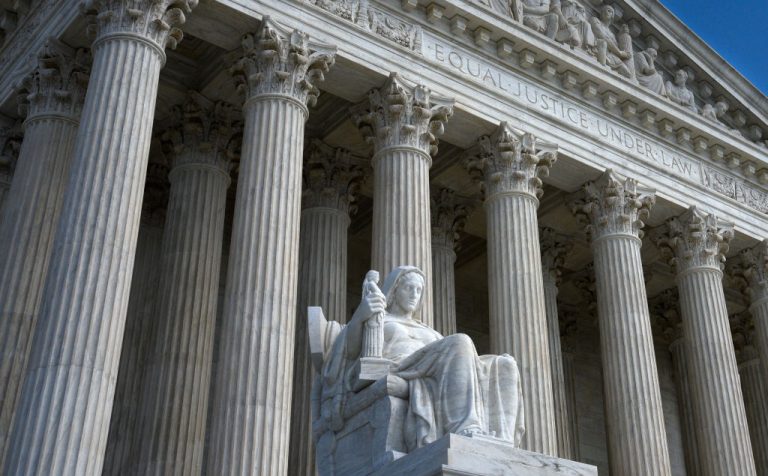An executive order by the Trump administration requiring federal buildings be constructed with classical architecture — and voided by Joe Biden during his first days in office — may see a renaissance with the reintroduction of a similar bill in the now Republican-controlled House of Representatives.
Rep. Jim Banks (R-IN) introduced the Beautifying Federal Civic Architecture Act on May 25. Although the text of the bill does not yet appear on the official Congress website, Fox News stated in a same day article on the topic that “the legislative framework is modeled after Trump’s executive order” and “declares ‘traditional and classical’ architectural styles to be preferred for new Federal government buildings.”
In December 2020, as Trump served his final days in office, he issued EO 13967 titled Promoting Beautiful Federal Civic Architecture, which acknowledged that the Founding Fathers had modeled government buildings with inspiration taken from Athens and Rome.
“They sought to use classical architecture to visually connect our contemporary Republic with the antecedents of democracy in classical antiquity, reminding citizens not only of their rights but also their responsibilities in maintaining and perpetuating its institutions,” the EO stated.
MORE ON CLASSICAL ARCHITECTURE
- Traditional Chinese Architecture – The Siheyuan
- Sustainable Architecture: The Gassho-Zukuri Houses of Japan
- Aspiring Artist Captures Minute Details of Architectural Masterpieces Around the World
- The Traditional Chinese Garden – A Miniature of Nature, in Harmony With Man
Fox quoted the bill put forward by Rep. Banks as stating, “The term ‘traditional architecture’ includes classical architecture; and the historic humanistic architecture, including Gothic, Romanesque, Pueblo Revival, Spanish Colonial, and other Mediterranean styles of architecture historically rooted in various regions of America.”
Success
You are now signed up for our newsletter
Success
Check your email to complete sign up
Another key feature of Trump’s EO was that it specifically targeted the modern “brutalism” architecture style, preventing it from being employed by designers, lamenting that “in Washington, DC, Federal architecture has become a discordant mixture of classical and modernist designs.”
Fox noted that the new bill likewise targets brutalism and states that new designs must be modeled after “Greek and Roman antiquity,” citing the U.S. Capitol and the Supreme Court of the United States building as references.
Banks was quoted as telling Fox News that the matter came down to upholding “American culture.”
“The intentional design of some of our greatest landmarks goes back to our Founding Fathers, who knew the importance architecture played in the establishment of American culture,” the Representative stated.
Banks added, “Requiring all new construction be thoughtfully developed in that same spirit preserves American exceptionalism and ensures federal buildings serve as a beautiful testament to our nation’s greatest ideals for generations to come.”
An anonymous Trump administration official who worked on the December of 2020 order shared with The Epoch Times similar thoughts in an interview, “I think the classical architecture of Greece and Rome is very wholesome, and it brings out the inherent order, structure, and beauty that humans crave.”
“I think the ultimate destroyer of human good is chaos. And I think that’s what brutalism is — it’s chaos. There’s no order. It’s just a bunch of concrete. It’s not nurturing,” the official added.
When Joe Biden took office as the 46th President of the United States on Jan. 20, 2021, he issued 15 executive orders and two presidential proclamations in his first hours, many of which sweepingly rescinded Trump’s EOs and decrees.
Slightly over a month into his term, Biden rescinded EO 13967.
President Peter Exley, at the time President of the American Institute of Architects (AIA), celebrated the decision in comments to design industry magazine Dezeen at the time on the basis that it “restored communities with the freedom of design choice that is essential to designing federal buildings that best serve the public.”
Exley claimed it was “fundamental” to the ability for an architect to “achieving the highest quality buildings possible.”
The AIA under Exley condemned Trump’s EO in early 2020, months ahead of the election, when a draft of it was leaked to the press, on the basis that, “All architectural styles have value and all communities have the right to weigh in on the government buildings meant to serve them,” Dezeen also reported.
Exley left his post as President of the AIA after winning a second appointment in 2021. In March, he accepted an appointment as Dean of the Scott Sutherland School of Architecture and Built Environment at the Robert Gordon University in Scotland, according to industry outlet Archinect.
Fox reported that National Civic Art Society President Justin Shubow was supportive of the new bill in the House on the basis, “The current government process for choosing building designs involves zero input from the community, this legislation democratizes design by requiring that there be substantial input from the general public.”
Shubow added, “It is crucial that the design of federal buildings reflects the preferences of ordinary Americans — namely, that such buildings be beautiful, uplifting, and designed in a classical or traditional style.”
The process referred to by Shubow is one Fox explains as the bill including provisions to create the “President’s Council on Improving Federal Civic Architecture” that will be round tabled by:
- Former Chairman of Commission of Fine Arts
- Present Chairman of Commission of Fine Arts
- The Architect of the Capitol
- The Commissioner of the Public Building Service of the Administration
- The Chief Architect of the Administration
However, even if the bill is to pass the Republican-controlled House, it must then win a majority in the Democrat-controlled Senate and avoid a Presidential Veto by Joe Biden.
If the bill was to pass the Senate and Biden were to Veto, the bill would require the support of a supermajority in the House, but after the 2022 primaries, the House is split 222 Republican to 213 Democrat.
















